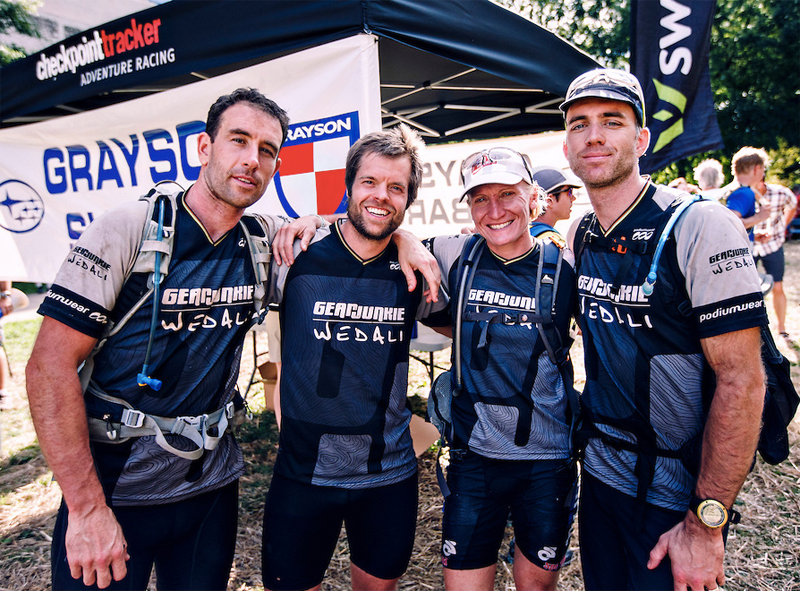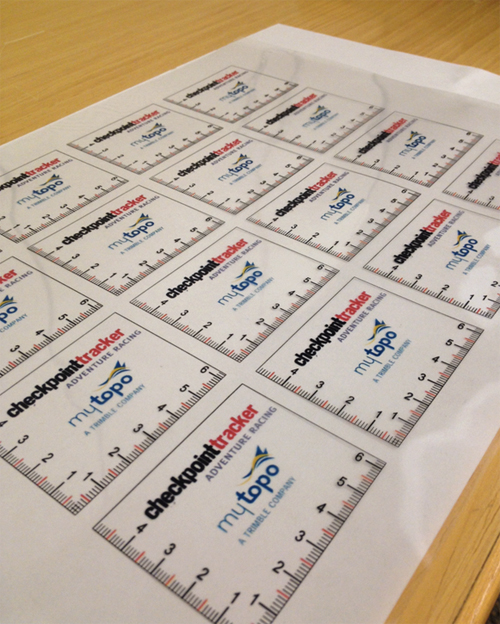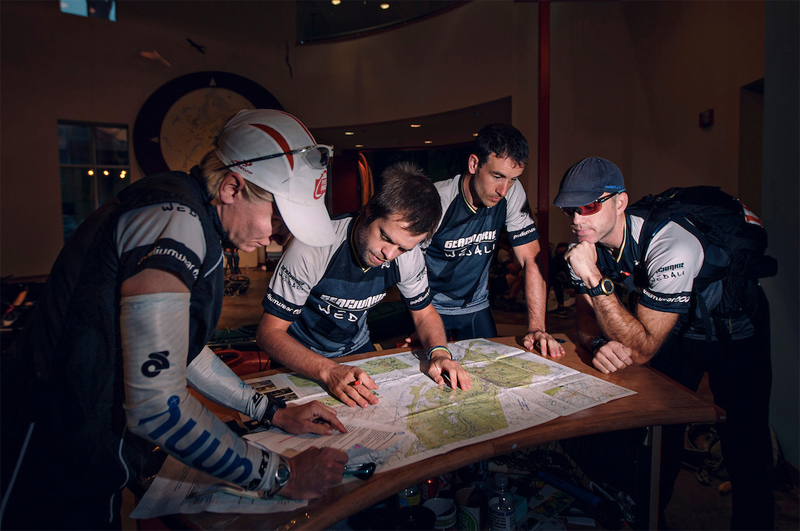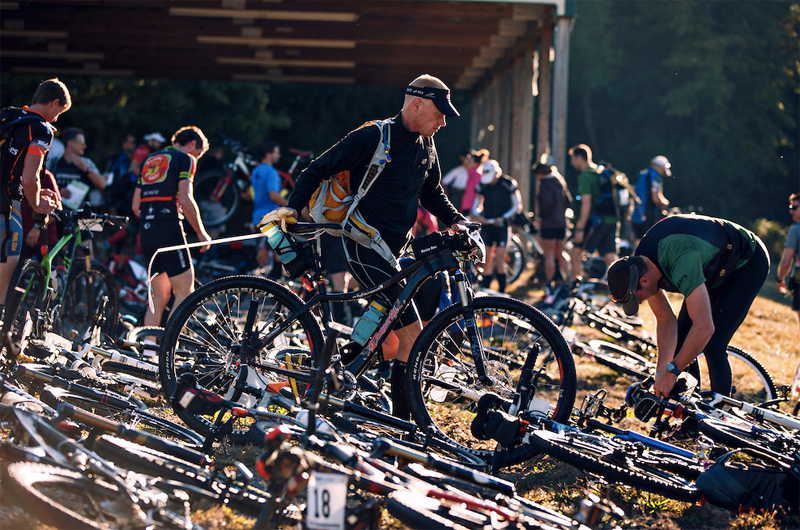GearJunkie editor Stephen Regenold raced in the 2013 Checkpoint Tracker Championship event, a nationally-attended adventure race held October 11 – 12 in Knoxville, Tenn.
Brakes squeak. Bike tires bump off the road. The team is stopping for a minute to glance at a map. It is 3am somewhere outside of Knoxville, Tenn., and I am falling asleep on my bike.
I shut my eyes and hang my head for a brief pause. Deep black, and an instant dream. I’m half-asleep standing up. “OK, let’s go!” wakes me, our team captain shouting, and we’re off again into the night.

It’s the 2013 Checkpoint Tracker Championship, a 30-hour nonstop adventure race that caps a national series. Our Team GearJunkie/WEDALI won the race last year along with the other big annual adventure racing competition, the USARA National Championships, crowning our squad as the best in the country.
Our luck this year was not as good. In the end we nabbed second-place at the Checkpoint Tracker Championship.
It was a tough course with even tougher logistics. In 30 hours each team had to find as many checkpoint flags as possible by bike, foot, and boat on a course that stretched more than 100 miles and climbed many mountains along the way.

Our competition was high, including the 2013 USARA Nationals winner Team Tecnu. With more than 125 racers from around the U.S. the field was thick with contenders.
The race started at 10am on Friday and it didn’t stop ‘til Saturday at 4pm. In that time, each team had to plot dozens of checkpoints on sets of topo maps and then chart a course of their choosing to best navigate through the rugged Tennessee hills.
Correction: Mountains. These were no “foothills,” as Team GearJunkie/WEDALI racer Mari Chandler jokingly commented near the start. (She lives at 7,500 feet in a house in the Sierra Nevada Mountains.)

The morning of the race our team captain and navigator Justin Bakken used a red Sharpie marker to plot checkpoints on a topo map. “These contour lines are 100 feet each,” he said, startled at the steep land.
The “hills” shot up from low valleys and climbed past 2,000 feet on many sections. We hit the first one soon after the “GO!” from race director Peter Jolles at the start of the event.
A trail rocketed down a rocky sweep off the start area, mud sputtering and roots chattering mountain bike frames as teams vied for position. We hit a country road, took a right turn on a two-track, and then we down-shifted to pedal uphill and into the woods.

Drama came within the first half-hour when Bakken crashed. He went down hard and cracked the valve off a water bottle. “Guess we gotta drink it now,” he said, dusting off.
Later, after nabbing the first checkpoint in a ravine, we heard a crackling noise, like metal on metal, from our teammate Tom Puzak’s direction. His bike’s bottom bracket was in the hurt. We stopped to tighten the crank by hand (no one had a #10 wrench) and prayed it’d hold steady for the 29+ hours remaining in the race. (Graciously, it did.)
We pedaled uphill, further and further above the start area. Fall colors bloomed in the trees higher up, and the sun beamed down. Huge hillsides were coated in leafy waves of kadzu, an invasive vine that covers anything in its path.
The first half-day was spent mountain biking on ATV trails, running in and out of the woods to stamp our race passport at checkpoints, and attempting to stay hydrated and fed as sweat poured.
We crested the highest point on the first part of the course to try and find a checkpoint flag placed at “an old power pole,” as our cluesheet said. On top, after a massive granny-gear pedal uphill, we hunted for the checkpoint with no luck — the flag was no where to be found, ostensibly stolen by someone not associated with the race.

By late afternoon we were back at the start area. A short orienteering course and a gun-range challenge were next. I shouldered a rifle and aimed at a pumpkin — you got eight shots to hit the target and score a point. No problem.
A vast trekking section was next, and it took our team back up the mountain to a trailhead. We’d spend most of the night climbing hills off-trail, running on meandering paths, and punching in at checkpoint flags scattered miles apart.

Two or three times, we heard voices in the dark woods or saw headlamp beams far off. It seemed like we were racing alone. We ran into Team Tecnu twice, but otherwise we saw no other racers that deep in the wilderness course.
Until this point, our team was attempting to “clear the course” and get every checkpoint out there on the whole race. Indeed, we debated and did the math, trying to estimate how long each leg going ahead would take and if completing all the points was even possible.
Still ahead on our map was a 27-mile bike leg, a 28-mile paddle section on the Tennessee River, multiple orienteering points, a caving section, and rope challenges.

A high concentration of checkpoints sat near the race finish line in Knoxville. Around midnight, our team decided to head out of the mountain wilderness and leave a few checkpoints unclaimed. It was a strategy move that almost gave us the victory.
Team Alpine Shop, with racers Doug Nishimura, Jeff Sona, David Frei and Emily Korsch, had left the mountain more than two hours before us. They had skipped a few more checkpoints than us, banking on making up the missing points in Knoxville before the race end.
In contrast, the racers on Tecnu, a squad who was among the favored teams to win, opted to stay longer than GearJunkie/WEDALI and nab more points in an attempt to clear the course.
Alpine Shop’s strategy played out best in the end. They pulled off the win with the same amount of checkpoints as Team GJ/WEDALI, though they finished about 20 minutes ahead.
Tecnu had fewer checkpoints and also did not make it to the end in time by the 4pm mandatory cutoff. The team received a DNF and was not happy with the course format, writing on its Facebook page that the race was “a mass confusion.”

Making sense out of the course was indeed not easy. With many unknown variables it was difficult to decide how to race. Luck played a role in the final outcome to an extent, but race strategy was even more crucial.
Mari Chandler, who has competed all over the world and was among the most experienced athletes at the CP Tracker race, wrote after the event: “It was a big race course and strategy was key. Teams who planned correctly did well. We [GearJunkie/WEDALI] had a pretty good plan, but unfortunately grabbed one too many of the difficult trekking CPs early on and ended up in 2nd-place by only 20 minutes. Yes, instructions were a bit confusing, and yes one of the CPs was missing/stolen, but none of the 29 CPs that we pursued were misplaced (but just on small features on a less than detailed map). I’m bummed we didn’t get to complete the whole thing… under the 30-hour cutoff time. It would have been a great 36-hour race.”
Our squad did its best to stay steady and tick off as many checkpoints as possible.
continued on next page. . .